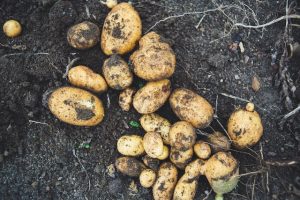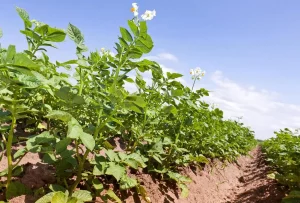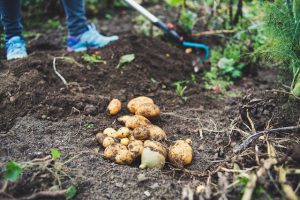
Potatoes are a staple food crop for people all over the world. Growing or Planting Potatoes on your own can be a rewarding experience, and the good news is, you don’t need a green thumb to do it! In this comprehensive guide, we’ll walk you through the steps of planting potatoes, from selecting the right variety to harvesting a bountiful crop.
In this blog post, we will walk you through the entire process of planting potatoes, from choosing the right seed potatoes to harvesting your crop. We will also cover some tips for growing potatoes in different climates and conditions.
[ez-toc]
A Guide to Planting Potatoes
Choosing the Right Potato Varieties
The first step to planting potatoes is to choose the right seed potatoes. Seed potatoes are small potatoes that are specifically grown for planting. They can be purchased from garden centers or online retailers.
When choosing seed potatoes, look for ones that are firm and disease-free. Avoid potatoes that are shriveled, soft, or have any cuts or bruises.
You should also choose a variety of potatoes that is well-suited to your climate and growing conditions. Some popular potato varieties include:
- Early Varieties:
- Yukon Gold
- Red Norland
- New Potatoes
- Mid-Season Varieties:
- Kennebec
- Purple Majesty
- Chieftain
- Late Varieties:
- Russet
- Idaho
- King Harry
Preparing Your Potato Seed
Potatoes are usually grown from seed potatoes, which are small potatoes or cut pieces of larger ones. Here’s how to prepare your seed potatoes for planting:
- Choose Healthy Potatoes:
- Select disease-free, certified seed potatoes from a reliable source.
- Cutting the Seed Potatoes:
- Cut the seed potatoes into pieces, making sure each piece has at least one or two eyes (buds). Allow the cut pieces to air dry for a day or two before planting.
Preparing the soil
Potatoes prefer well-drained soil with a pH of 6.0-7.0. If your soil is acidic, you can add lime to raise the pH. If your soil is heavy clay, you can improve drainage by adding sand or compost.
Before planting potatoes, it is important to prepare the soil. This involves removing any weeds or debris and loosening the soil to a depth of at least 8 inches.
You can also add some compost or manure to the soil to improve fertility.
Planting Potatoes
Now, let’s get our hands dirty and start planting those potatoes!
Potatoes can be planted in the ground or in containers. If you are planting in the ground:
Select a Planting Site: Choose a sunny spot in your garden with well-draining soil. Potatoes prefer slightly acidic to neutral soil (pH 5.8 to 6.5).
Prepare the Soil: Loosen the soil and mix in well-rotted compost or organic matter to improve its structure and fertility.
Plant the Potatoes: Dig shallow trenches about 4 inches deep and space them about 2-3 feet apart. Place the potato pieces (cut side down with the eyes facing up) in the trench, spacing them 10-12 inches apart.
Cover and Water: Cover the potatoes with about 3-4 inches of soil. Water thoroughly to settle the soil and encourage growth.
If you are planting in containers, choose containers that are at least 12 inches deep and have drainage holes. Fill the containers with potting mix and place the seed potatoes in the center of the pot with the eyes facing up. Cover the potatoes with potting mix and water well.
Caring for Your Potato Plants

Potatoes need consistent care to ensure a healthy and abundant crop. Here are some essential care tips:
Watering
Potatoes need regular watering, especially during the first few weeks after planting. Water deeply once a week, or more often if the weather is hot or dry. Keep the soil consistently moist but not waterlogged. Potatoes need about 1-2 inches of water per week.
Hilling:
Hilling potatoes is the process of mounding soil up around the plants as they grow. This helps to protect the developing tubers from sunlight and pests.
As the potato plants grow, gradually mound soil around the base of the plants using a hoe or shovel to protect the tubers from exposure to sunlight. Hilling also encourages additional tuber growth. Be careful not to damage the roots.
Fertilizing:
Potatoes also need to be fertilized regularly. Fertilize every two weeks with a balanced fertilizer.
Apply a balanced fertilizer at planting and during the growing season to provide essential nutrients for growth. Follow the recommended rates for potatoes.
Pest and Disease Management:
Monitor your plants regularly for signs of pests or diseases. Neem oil or organic insecticidal soaps can be used for pest control, and crop rotation helps prevent disease.
Potatoes are susceptible to a number of pests and diseases. Some common potato pests include:
- Colorado potato beetles
- Aphids
- Wireworms
Some common potato diseases include:
- Late blight
- Early blight
- Scab
To control pests and diseases, you can use a variety of methods, including:
- Crop rotation
- Companion planting
- Insecticides
- Fungicides
Harvesting Your Potatoes

Potatoes are ready to harvest when the foliage starts to turn yellow and die back. To harvest potatoes, simply dig them up with a shovel or fork.
Be careful not to damage the tubers when harvesting. Store potatoes in a cool, dark place.
The time to harvest potatoes varies based on the variety you planted. Here’s a general guideline for harvesting:
- Early Potatoes: Harvest as soon as the potatoes are a usable size (usually around 75-90 days after planting).
- Mid-Season Potatoes: Harvest when the plants flower and the foliage begins to turn yellow (around 90-120 days after planting).
- Late Potatoes: Harvest when the foliage dies back completely (120-150 days after planting).
Carefully dig around the plant to unearth the potatoes, being gentle to avoid damaging them. Allow them to air-dry for a few hours before storing them in a cool, dark, and well-ventilated place.
Tips for growing potatoes in different climates
Potatoes can be grown in most climates, but there are a few things to keep in mind if you are growing potatoes in a hot or cold climate.
If you are growing potatoes in a hot climate, it is important to choose a variety that is heat-tolerant. You should also water your potatoes more often and mulch around the plants to help keep the soil cool.
If you are growing potatoes in a cold climate, it is important to protect your plants from frost. You can do this by covering the plants with a frost blanket or by planting them in a raised bed.
Potato Pests and Diseases
| Pest/Disease | Type | Symptoms | Control/Prevention |
|---|---|---|---|
| Colorado Potato Beetle | Pest | Striped yellow-orange beetles, larvae eating foliage | Handpick, use neem oil, insecticidal soap, crop rotation |
| Potato Aphids | Pest | Tiny, green, yellow, or pink insects on leaves and stems | Use insecticidal soap, neem oil, ladybugs, insecticides |
| Potato Flea Beetle | Pest | Small, shiny beetles that create small holes in leaves | Insecticidal soap, neem oil, insecticides |
| Late Blight | Disease | Dark, water-soaked lesions on leaves and stems | Fungicides, crop rotation, resistant varieties |
| Early Blight | Disease | Dark, concentric circles on leaves, yellowing, and wilting | Fungicides, crop rotation, proper plant spacing |
| Potato Scab | Disease | Raised, corky lesions on the potato surface | Maintain soil pH, reduce irrigation fluctuations |
| Verticillium Wilt | Disease | Yellowing, wilting, and stunted growth of leaves and stems | Resistant varieties, soil solarization |
| Potato Cyst Nematode (PCN) | Disease | Stunted growth, yellowing, and wilting of plants | Crop rotation, use certified seed potatoes |
Conclusion on Planting Potatoes
Planting potatoes can be a satisfying and rewarding experience that can provide you with a delicious and nutritious crop. Whether you’re a seasoned gardener or just starting out, growing your own potatoes is a rewarding venture. With the right preparation, care, and a little patience, you’ll soon be enjoying the taste of freshly harvested potatoes straight from your garden. By following the tips in this blog post, you can easily grow potatoes in your own garden. Happy gardening!
FAQs About Growing Potatoes
When to Plant Potatoes in North Carolina (NC)
In North Carolina (NC), the timing for planting potatoes largely depends on the specific region within the state and the prevailing climate conditions. Generally, potatoes are cool-season crops, and they grow best in cool weather. Here’s a general guideline for planting potatoes in North Carolina:
Coastal Region (Eastern NC): Planting can start as early as late January to early February if weather and soil conditions permit. The main planting window is from late February to mid-March.
Central Region (Raleigh, Durham, Greensboro): Planting typically starts in late February to mid-March.
Mountain Region (Asheville, Boone): Planting usually begins in mid to late March.
It’s essential to monitor soil temperatures and weather conditions before planting. Potatoes require a soil temperature of at least 45-50°F (7-10°C) for proper germination and growth. Planting too early when the soil is still cold can result in poor germination and slow growth.
When to Plant Potatoes in Georgia
In Georgia, the ideal time to plant potatoes is typically in late winter to early spring, specifically from late January to early March. The exact timing can vary slightly based on the region within Georgia and the specific climate conditions of the year. Here’s a breakdown of when to plant potatoes in Georgia:
- Coastal Georgia (Southern Part of the State):
- Planting typically starts in late January to early February.
- Central and Piedmont Regions:
- Planting usually begins in mid-February to early March.
- Northern Georgia (Mountainous Regions):
- Planting starts in early to mid-March.
Potatoes prefer cool weather and can tolerate light frosts, so planting them early in the year ensures they have ample time to grow and produce before the hot summer temperatures set in. It’s important to aim for a planting date when the soil temperature is at least 45-50°F (7-10°C) for proper germination and growth.
When to Plant Potatoes in Michigan
In Michigan, the best time to plant potatoes is during the spring, typically between late March and early May, depending on the region and local weather conditions. Potatoes are a cool-season crop, and they thrive in cooler soil and air temperatures.
Here’s a more detailed planting timeline based on regions in Michigan:
- Southern Michigan:
- Start planting in late March to early April, as this region experiences slightly milder temperatures during the early spring.
- Central Michigan:
- Begin planting in mid-April, allowing the soil to warm up sufficiently for optimal germination and growth.
- Northern Michigan:
- Start planting in late April to early May, once the threat of frost has passed and the soil has warmed up adequately.
Keep in mind that potatoes prefer a soil temperature of around 45-50°F (7-10°C) for optimal growth and germination. It’s important to ensure that the soil is workable and not too wet when you plant.
When to Plant Potatoes in Tennessee
In Tennessee, the ideal time to plant potatoes is typically during the late winter to early spring, when the soil is workable and temperatures are suitable for tuber development. Here’s a general planting timeline based on different regions within Tennessee:
- East Tennessee:
- Start planting in late February to early March as the weather begins to warm up. This region tends to have milder winters, allowing for earlier planting.
- Middle Tennessee:
- Begin planting in mid to late March as temperatures become consistently favorable for planting and growth.
- West Tennessee:
- Start planting in late March to early April. This region may have slightly warmer temperatures earlier in the year, allowing for an early spring planting.
It’s essential to monitor soil temperatures and aim for a soil temperature of at least 45-50°F (7-10°C) for proper germination and growth of potato seeds.
When to Plant Potatoes in Colorado
In Colorado, the best time to plant potatoes is typically during the spring, specifically in April. Colorado’s climate can vary significantly depending on the specific region and altitude, so adjusting the planting time accordingly is crucial for a successful potato crop.
Here’s a general planting timeline for potatoes in Colorado based on the different regions:
- Front Range (Denver, Colorado Springs):
- Start planting in early to mid-April, once the soil has thawed and temperatures are consistently above freezing.
- Mountain Region (Aspen, Vail):
- Begin planting in mid to late April, allowing the soil to warm up adequately at higher altitudes.
- Western Slope (Grand Junction, Montrose):
- Start planting in mid-April, making sure to choose varieties suitable for the region’s growing conditions.
- Eastern Plains (Fort Morgan, Sterling):
- Planting can begin in early to mid-April, but monitor the weather and soil conditions closely.
When to Plant Potatoes in Arkansas
In Arkansas, the best time to plant potatoes is typically during the late winter to early spring, aligning with the cool-season growing requirements of potatoes. Here’s a general planting timeline based on different regions within Arkansas:
- Northern Arkansas:
- Begin planting in late February to early March, as this region experiences a slightly milder climate during the early spring.
- Central Arkansas:
- Start planting in early to mid-March, ensuring that the soil has thawed and is workable for planting.
- Southern Arkansas:
- Begin planting in mid to late March, as this region tends to experience warmer temperatures and an earlier onset of spring.
When to Plant Potatoes in Kansas
In Kansas, the best time to plant potatoes is typically during the late winter to early spring, aligning with the cool-season growing requirements of potatoes. The timing will vary slightly based on the region and local weather conditions, but here’s a general planting timeline for potatoes in Kansas:
- Eastern Kansas:
- Begin planting in late February to early March, depending on the weather and soil conditions. This region experiences slightly milder winters.
- Central Kansas:
- Start planting in early to mid-March. As temperatures rise, this period provides a good window for planting.
- Western Kansas:
- Begin planting in mid-March to early April, considering the region’s cooler temperatures.
It’s important to monitor soil temperatures and aim for a soil temperature of at least 45-50°F (7-10°C) for proper germination and growth of potato seeds.
When to Plant Sweet Potatoes in Texas
In Texas, the best time to plant sweet potatoes is during the warm spring months, typically between late March and early June. Sweet potatoes thrive in warm soil and need a long growing season, making the spring and early summer the ideal planting time. Here’s a more detailed planting timeline for sweet potatoes in Texas:
- South Texas (Rio Grande Valley, Laredo):
- Start planting in late March to early April, as this region experiences warmer temperatures earlier in the year.
- Central Texas (Austin, San Antonio):
- Begin planting in mid-April to early May, taking advantage of the warmer temperatures as they become consistent.
- North Texas (Dallas, Fort Worth):
- Start planting in early to mid-May, ensuring the soil has warmed sufficiently for successful germination and growth.
When to Plant Potatoes in Iowa
In Iowa, the best time to plant potatoes is during the early spring when the soil is workable and temperatures are suitable for the growth of cool-season crops. Potatoes require cool soil to sprout and establish healthy plants. Here’s a general planting timeline for potatoes in Iowa:
- Early Planting (South Iowa):
- Begin planting in mid to late March, as southern parts of Iowa experience milder winters and earlier spring temperatures.
- Mid-season Planting (Central Iowa):
- Start planting in early to mid-April. Central Iowa typically experiences moderate spring temperatures.
- Later Planting (North Iowa):
- Begin planting in mid to late April. Northern parts of Iowa have cooler spring temperatures, so planting slightly later is advisable.
When to plant Potatoes in Mississippi
In Mississippi, the ideal time to plant potatoes is during the late winter to early spring months. Potatoes are a cool-season crop, and they thrive in cooler soil and air temperatures. Here’s a general planting timeline for potatoes in Mississippi:
- Southern Mississippi:
- Start planting in late January to early February, as the southern part of Mississippi experiences milder winter temperatures and an early onset of spring.
- Central Mississippi:
- Begin planting in mid to late February, as temperatures start to rise and the soil becomes workable.
- Northern Mississippi:
- Start planting in late February to early March. Northern parts of Mississippi might still experience cooler temperatures during this period.